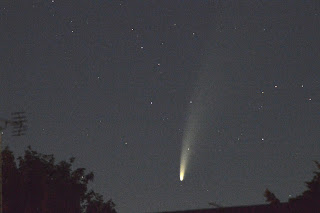May 31st 0900 GMT Sun
May 28th 2200 GMT Binocular Sky Tour
May 24th Sun
May 22nd 1125 GMT Sun
After a cloudy start, I photographed the Sun with my DSLR and filter at 300mm focal length, ISO 100 and 1/2000 second exposure. I could clearly see the sunspot group in my viewfinder.
May 22nd 2330 GMT Meteor Hunt
It finally cleared enough to do some meteor shots. The Eta Lyrids were theoretically active, although the chances of bagging a sporadic meteor in that part of the sky was somewhat higher! I aimed my camera, at the usual settings at Cygnus and Lyra and hoped!
I stacked 30 of the first 40 images to get a nice shot of Cygnus and Lyra, also showing Sagitta and Vulpecula.
May 21st 1220 GMT Sun
I had my first look at the Sun, or anything else, for ages and caught it through clouds. There was an enormous sunspot group.
May 17th 1130 GMT
I bin scanned the Sun in a clear sky. The prominent sunspot group I had been following had apparently reduced to a single, small sunspot, whereas new activity had rotated onto the solar disc.
May 14th 1625 GMT Sun
Conditions were hazy but I managed to see several sunspots.
May 14th 2300 GMT
May 13th 1800 GMT Sun
May 12th 0540 GMT Sun
Our nearest and dearest star is more than capable of throwing up surprises in a short time. I bin scanned the Sun, expecting to see a lot of Earth’s rotation since the previous evening and, perhaps, a little bit of solar rotation. Instead, I recorded an additional sunspot. A later look at the Learmonth images showed that the largest sunspot consisted of two plus a myriad of smaller sunspots that were below the resolution of my binoculars and certainly my camera.
May 11th 2045 GMT ISS and Moon
May 11th 1810 GMT Sun
May 8th 2000 GMT Moon
It was clear but I had work the next day,
so I snapped the Moon with my DSLR at 300mm focal length, ISO 100 and 1/400
second exposure.
May 8th 0915 GMT Sun
I snapped the Sun with my DSLR and filter
at 300mm focal length, ISO 100 and 1/4000 second exposure. The conditions were
poor but there was always a chance.
I caught a sunspot about to rotate off.
May 7th 2035 GMT Moon
May 7th 0800 GMT Sun
May 7th Comet NEOWISE F3 Reprocess
May 6th 0905 GMT Sun
While waiting
for the kettle to boil, I took a quick photo of the Sun with my DSLR and filter
at 300mm focal length, ISO 100 and 1/2000 second exposure.
May 5th 2040 GMT Moon
The Moon had “grown” in phase, so I
reduced the exposure time to 1/250 second, keeping the ISO setting at 100 and
the focal length at 300mm.
May 5th 1110 GMT Sun
The weather
was better than the forecast suggested. I snapped the Sun with my DSLR at 300mm
focal length, ISO 100 and 1/2000 second exposure. I could see the two large
sunspots through the viewfinder, so had cause for optimism.
May 5th 0540 GMT Sun
I bin scanned the Sun early because I
caught it in a patch of clear sky and the weather forecast for later was not
promising.
May 4th Electronic Eyepiece
My tenner’s worth of Angeleyes electronic
eyepiece arrived today ahead of schedule. I ran some indoor tests on it with
Sharpcap. Fortunately, it installed easily without the problems I sometimes get
with devices. Shame I cannot get my Phillips SPC880 to run on Windows 10 but
that’s a common problem.
I seemed to allow me to select frame
rates from 1 per 30 minutes to 480 frames per second. Whether it could deliver
that it practice remained to be seen! At least I was ready when the Moon was
about and it wasn’t a “school” night.
May 4th 2100 GMT Moon
I snapped the thin crescent moon with my
DSLR at 300mm focal length, ISO 100 and 1/200 second exposure.
May 4th 1100 GMT Sun
May kicked off with a sunspot drawing and
there had been a lot of movement and transformation since my previous viewing
on April 30th.

































